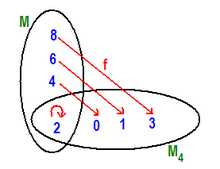Finite set
In set theory, a branch of mathematics, a finite set is a set with finitely many elements. For example, the set
is a finite set with four elements. According to its definition, the empty set has no elements, i.e. the number of elements is 




A set that is not finite is called an infinite set.
Definition
A set 




In particular, the empty set 



For example, the amount
finite, since a bijection to the set
exists, see for example the figure opposite.
With this enumerative set notation, the order is not important. Furthermore, an element that is mentioned more than once is only included once. It is therefore for example

For the set of all natural numbers
on the other hand, no such bijection exists on a finite set, the set 
Basic properties of finite sets
- Any subset of a finite set
is also finite.
- In particular, if
a finite set and
is an arbitrary set, then both the intersection
and the difference
finite sets, because both are subsets of
.
- If
are finite sets, then their union
is also finite. For their powers,
.
Ifand
arefinite and disjoint, that is,
then one has
.
- In general, a union of finitely many finite sets is again a finite set. Its power is given by the principle of inclusion and exclusion.
- If
is infinite and
is finite, then is
infinite.
- The power set
of a finite set
has power greater than the set itself, but is still finite; it holds
.
- The Cartesian product
of finite sets is finite. Its power is higher than that of all factors involved if no factor is empty and at least two factors have power greater than .
For finite sets ,
. More generally, a Cartesian product of finitely many finite sets is again a finite set.
Search within the encyclopedia






